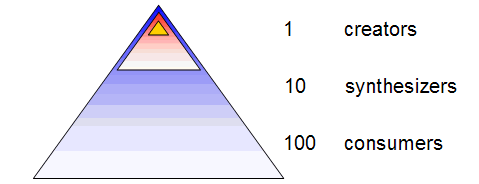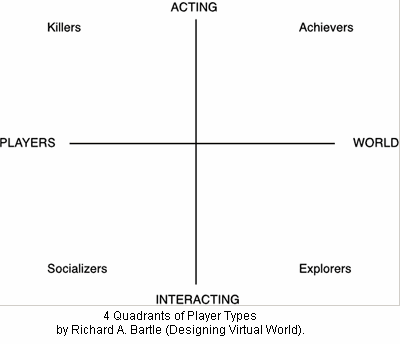Social gaming design – Bartle types versus Web 2.0 participation pyramid
By spending time in the “social gaming” space, it’s interesting to see the intersection of approaches from both the consumer internet folks versus the traditional game folks. In addition to business models (ads versus subs/virtual goods) or product emphasis (functionality versus storytelling/characters/etc) or other topics, I’m particularly fascinated by the difference in how they think about their players/users and their activities.
Let’s look at the two approaches – both the “Web 2.0” view as well as the games perspective. The former is represented by a pyramid, and the other is a 2-axis landscape.
A while back, Bradley Horowitz (then at Yahoo) wrote an article on a “pyramid of value creation” classifying Creators, Synthesizers, and Consumers. He uses the following diagram and writes – bold formatting is mine:
The levels in the pyramid represent phases of value creation. As an example take Yahoo! Groups.
- 1% of the user population might start a group (or a thread within a group)
- 10% of the user population might participate actively, and actually author content whether starting a thread or responding to a thread-in-progress
- 100% of the user population benefits from the activities of the above groups (lurkers)
There are a couple of interesting points worth noting. The first is that we don’t need to convert 100% of the audience into “active” participants to have a thriving product that benefits tens of millions of users. In fact, there are many reasons why you wouldn’t want to do this. The hurdles that users cross as they transition from lurkers to synthesizers to creators are also filters that can eliminate noise from signal. Another point is that the levels of the pyramid are containing – the creators are also consumers.
The use of a pyramid reinforces some subtleties which I bold above:
- There’s a hierarchical view of how users are perceived, with a linear path
- Creators are generally seen as “higher value” than the less involved users
- There’s an effort to “convert” lower value users into creators
Another good discussion and example of the pyramid point of view is here at Jeremiah Owyang, in an article called See Actual % of “Community Pyramids” with Technographic Data.
Let’s return to the pyramid a bit later in this blog.
The Games point of view
The four things that people typically enjoyed personally about MUDs
were:i) Achievement within the game context.
Players give themselves game-related goals, and vigorously set out to achieve them. This usually means accumulating and disposing of large quantities of high-value treasure, or cutting a swathe through hordes of mobiles (ie. monsters built in to the virtual world).ii) Exploration of the game.
Players try to find out as much as they can about the virtual world. Although initially this means mapping its topology (ie. exploring the MUD’s breadth), later it advances to experimentation with its physics (ie. exploring the MUD’s depth).iii) Socialising with others.
Players use the game’s communicative facilities, and apply the role-playing that these engender, as a context in which to converse (and otherwise interact) with their fellow players.iv) Imposition upon others.
Players use the tools provided by the game to cause distress to (or, in rare circumstances, to help) other players. Where permitted, this usually involves acquiring some weapon and applying it enthusiastically to the persona of another player in the game world.
Later on in the article, he also touches on the dynamics between each one of these Bartle types, and how they interact to create the community that makes up a game. He also discusses methods of increasing or decreasing the prevalence of certain types, since oftentimes having too many or too little of a particular type can cause imbalance to the community.
A couple observations on this:
- The 4 types are primarily treated as peers to each other
- By presenting it as a 2×2 landscape, it also expresses the idea that a player might be in one type yet flirt with another
- Yet, the diagonals are problematic, since it’s hard to express an Achiever who is also a Socializer
Let’s compare the two viewpoints now.
Comparing the two perspectives
It’s clear that there are clear differences between the two views. While one more closely resembles a linear, hierarchical view, the other represents a flatter, multi-variable view.
In general, I think the two views are in conflict with each other due to the emphasis on user-generated content versus company-created content. In a pure UGC web 2.0 site, you need the content creators otherwise there’s nothing to do for anyone else. Take a site like Digg or Facebook, and if it’s just you on the site, it’s not so interesting. Compare this perspective to the games world, which has long built gradual “solo” experiences that then open into social experiences.
In almost any MMO, you can still play it for a while before you have to start thinking about other people. There’s a long “single user” experience that makes the game fun and entertaining, even if you’re the only person logged on. For socializers, you can talk to NPCs and get your kicks that way. For achievers, you can fight monsters and level up your character. For explorers, you can still check out the world and try out all sorts of different things. By investing in a content experience up-front, there’s less of a reliance on content creators to make it all work.
In general, comparisons like this make me think more about the user/player lifecycle of any product – how do you bootstrap the initial experience and make that fun? How do you pivot the user into trying other things, in particular with real live people? How do you build the critical mass to make social experiences interesting? As always, there’s a lot for Web folks (like me) to learn about from the games people.
Comments and suggestions always welcome!
PS. Get new updates/analysis on tech and startups
I write a high-quality, weekly newsletter covering what's happening in Silicon Valley, focused on startups, marketing, and mobile.
Views expressed in “content” (including posts, podcasts, videos) linked on this website or posted in social media and other platforms (collectively, “content distribution outlets”) are my own and are not the views of AH Capital Management, L.L.C. (“a16z”) or its respective affiliates. AH Capital Management is an investment adviser registered with the Securities and Exchange Commission. Registration as an investment adviser does not imply any special skill or training. The posts are not directed to any investors or potential investors, and do not constitute an offer to sell -- or a solicitation of an offer to buy -- any securities, and may not be used or relied upon in evaluating the merits of any investment.
The content should not be construed as or relied upon in any manner as investment, legal, tax, or other advice. You should consult your own advisers as to legal, business, tax, and other related matters concerning any investment. Any projections, estimates, forecasts, targets, prospects and/or opinions expressed in these materials are subject to change without notice and may differ or be contrary to opinions expressed by others. Any charts provided here are for informational purposes only, and should not be relied upon when making any investment decision. Certain information contained in here has been obtained from third-party sources. While taken from sources believed to be reliable, I have not independently verified such information and makes no representations about the enduring accuracy of the information or its appropriateness for a given situation. The content speaks only as of the date indicated.
Under no circumstances should any posts or other information provided on this website -- or on associated content distribution outlets -- be construed as an offer soliciting the purchase or sale of any security or interest in any pooled investment vehicle sponsored, discussed, or mentioned by a16z personnel. Nor should it be construed as an offer to provide investment advisory services; an offer to invest in an a16z-managed pooled investment vehicle will be made separately and only by means of the confidential offering documents of the specific pooled investment vehicles -- which should be read in their entirety, and only to those who, among other requirements, meet certain qualifications under federal securities laws. Such investors, defined as accredited investors and qualified purchasers, are generally deemed capable of evaluating the merits and risks of prospective investments and financial matters. There can be no assurances that a16z’s investment objectives will be achieved or investment strategies will be successful. Any investment in a vehicle managed by a16z involves a high degree of risk including the risk that the entire amount invested is lost. Any investments or portfolio companies mentioned, referred to, or described are not representative of all investments in vehicles managed by a16z and there can be no assurance that the investments will be profitable or that other investments made in the future will have similar characteristics or results. A list of investments made by funds managed by a16z is available at https://a16z.com/investments/. Excluded from this list are investments for which the issuer has not provided permission for a16z to disclose publicly as well as unannounced investments in publicly traded digital assets. Past results of Andreessen Horowitz’s investments, pooled investment vehicles, or investment strategies are not necessarily indicative of future results. Please see https://a16z.com/disclosures for additional important information.


